CyberPower Xplorer X6-9100: Gamers Need Not Apply
by Dustin Sklavos on May 4, 2011 12:00 AM EST- Posted in
- Laptops
- Intel
- Sandy Bridge
- CyberPowerPC
- Intel SSD 510
Application and Futuremark Performance
For the CyberPower Xplorer X6-9100 we're foregoing gaming testing; the X6-9100 employs Intel's Sandy Bridge HD 3000 integrated graphics, which we've spent a healthy amount of time testing already. Suffice it to say it's adequate for the most basic of gaming at the lowest settings (ignoring more intense games like Mafia II or Metro 2033), but you're not going to be playing a whole lot at the notebook's native 1080p resolution.
For the rest of our testing, we'll include a large selection of recent notebooks. We've highlighted the Xplorer in our standard green, with the Compal SNB test notebook in gold and the ASUS K53E in black. These two laptops will bracket the X6-9100 with the i7-2820QM plus 160GB SSD coming out on top and the i5-2520M plus HDD coming in below--although the 2520M has a higher IGP clock and thus will also lead in graphics testing by a small amount.
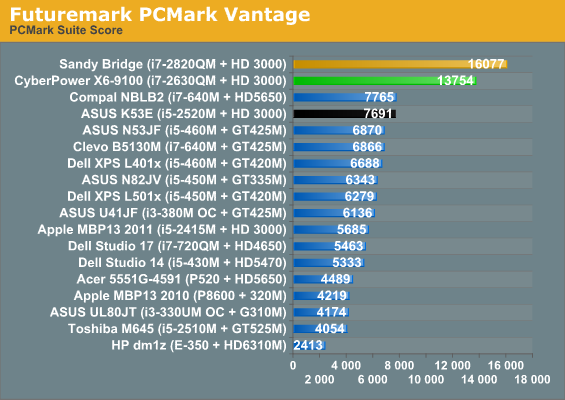
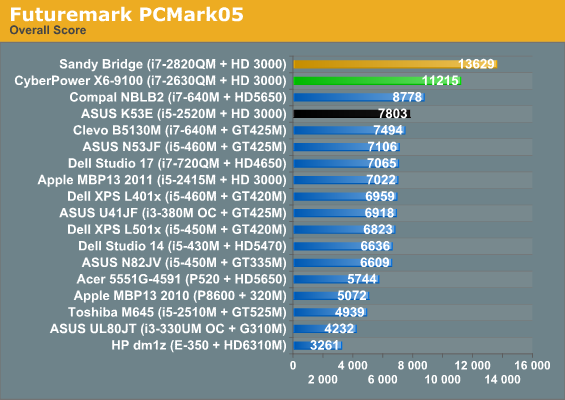
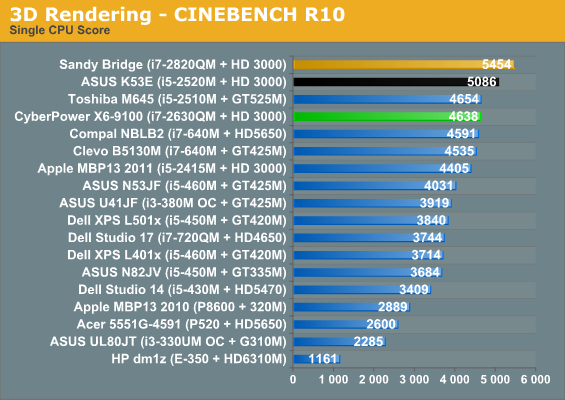
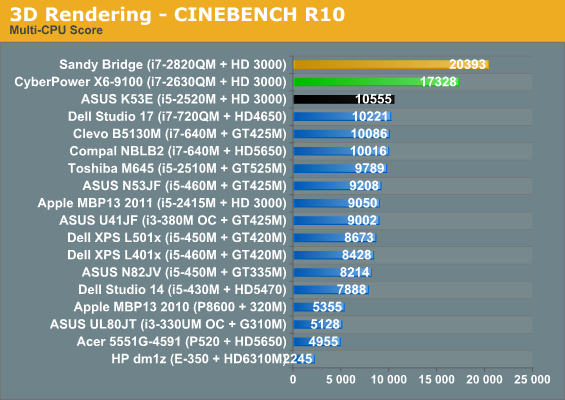
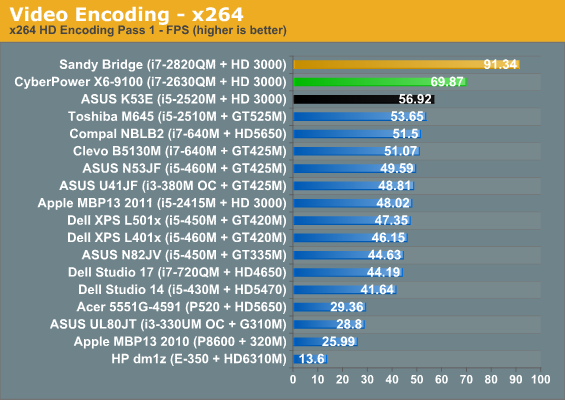

It should come as no surprise to anyone that the i7-2630QM is fast. Any discipline that takes advantage of the additional processor cores produces a staggering lead, far greater than Clarksfield had over Arrandale. The i7-2630QM is the slowest Sandy Bridge quad-core shipping right now, but it still boasts a substantial improvement over last generation's quads. If you're like me and get a decent amount of mileage out of having extra cores on tap, and you're using a Clarksfield notebook, Sandy Bridge makes a very convincing case for upgrading.

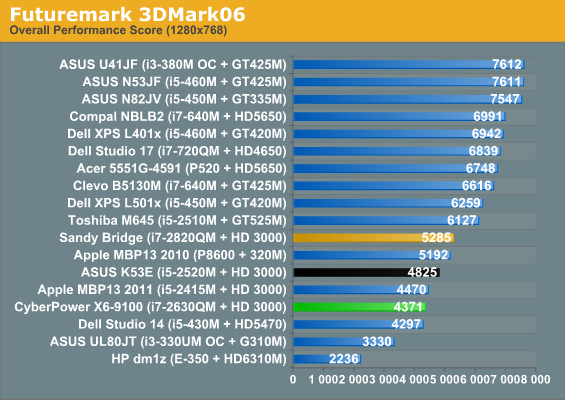
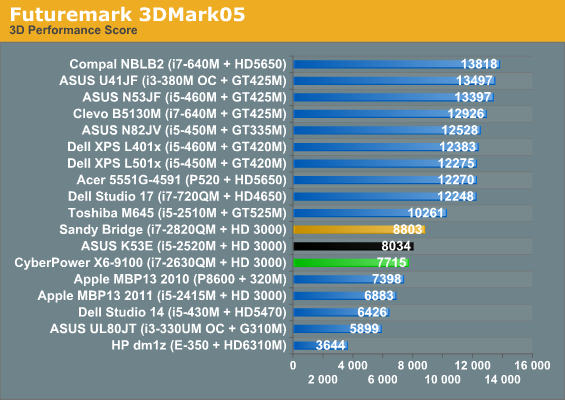
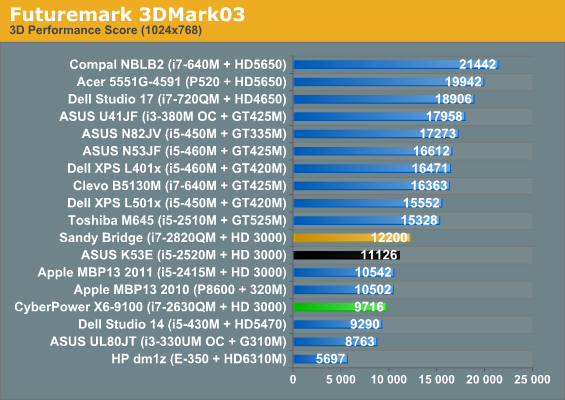
3DMark performance is low, but that's no surprise. Still, the Intel HD 3000 manages to achieve what we needed it to: it ties or beats performance of last generation's low-end dedicated graphics chips. We were stuck far too long with the likes of the GeForce 310M and the Mobility Radeon HD 5470, so it's nice to see Intel's integrated graphics finally make those chips more or less obsolete.










25 Comments
View All Comments
jabber - Wednesday, May 4, 2011 - link
Yeah its like a Sports car manufacturer building a half decent sports car chassis and then sticking a standard 4 cylinder 2000cc engine in it.I think something got missed in the design spec memo to the suppliers.
Another $20 on the panel choice could have worked wonders.
GullLars - Wednesday, May 4, 2011 - link
This is more like a sports car company taking a VolksWagen Beatle chassis and replacing everything with Bugatti Veyron parts. Sure it may go 0-60 in 3 seconds and have ~1000hp, but you can outrun it in an original Mazda R7 due to handling and aerodynamics, and it will just look ridiculous.I'd say $50 more on the panel rather than $20. Screen and battery are not things you cheap out on if you want a good laptop, and at >$700 saving $20-50 on a panel for the types of workloads this is meant for is pointless.
GullLars - Wednesday, May 4, 2011 - link
DOH! I meant Mazda RX-8...Iketh - Wednesday, May 4, 2011 - link
that comment would apply to the rx-7 too, figured that's what you were going forBelard - Wednesday, May 4, 2011 - link
..."shortcomings aren't CyberPower's fault any more than the Clevo notebooks we've reviewed are the fault of AVADirect or Eurocom."Actually, *IT* is CyberPowers, AVADirect, etc fault. The problems with that product in this review and other low-end garbage is that the "boutiques" / "Mom & Pop" stores CHOOSE to sell sub-standard garbage.
Then its up to the customer to either buy a quality, but perhaps somewhat slower $800 notebook that will last 3~5 years or $800 for one that is faster, but may last 6~12 months, have a crappy finish and other issues as noted in the review.
Back in the 90s - there used to be THOUSANDS of PC shops all over the USA, there was a point when Dell and Gateway were no different than any other hole-inthe-wall PC shop. But Dell decided to act like a bigger company and do bigger company things. When you buy better quality parts, you get a better computer, happier customers, less tech support calls, etc.
Back in the mid-90s, I managed a PC shop with 2~4 techs. As I gained experienced, I started to moved the company into using standards. Quality cases with decent PSUs (which costs like $5 more), better motherboards (we stopped selling PCCHips / ECS crap) - rather than typical small shops which buy whatever cheap junk is available - RIGHT NOW!
I work as a consultant today. Doing networks, building and maintain some systems for a few business. I don't build or sell my client anything *I* wouldn't want for myself, PERIOD.
I have desktops that have lived 5~8 years, still. I sell my clients Custom Ordered Thinkpads - which don't come preloaded with crapware (HPaq / Acer / Gateway).
I would never sell such crap to my customer, and it is within CyberPower's ability to say "nope, we are not going to sell this to our customer, this is why and do you have anything else?" Companies like Clevo make about 50 different notebook chassis at any given time. Just as much as you rejected the X6-9100, so can CyberPower.
A similar spec ThinkPad T520 (15.6”) is $1980… but you’d get a top end keyboard, no gloss anywhere on the notebook – not even the screen itself. But I can’t spend $2000 on a notebook. I wouldn’t blink to buy a slower T520 with the i5 CPU, 1080 LED anti-glare screen, 4GB RAM and 500GB HD for $1170. I don’t see how they can sell that for under $1100 with that SSD.
But here’s the thing… Lenovo (makers of ThinkPad) sells an ideaPad with a 14” screen, 750GB HD (no SSD), same CPU for $850… easy enough to add your own $250 SSD.
There are choices… thank God.
Dustin Sklavos - Wednesday, May 4, 2011 - link
I think part of the problem, though, is that Clevo, MSI, Compal, and Pegatron just...don't have very compelling ODM notebooks for the boutiques to sell. So it's either this stuff or nothing at all. They do the best they can with what they have, but oftentimes it's just not compelling compared to the kinds of stuff the Dells and HPs of the world can do.Belard - Wednesday, May 4, 2011 - link
BTW - Your review of the product was fair and your opinions on the product are valid, to me.But sorry, I don't agree with you on the point of what "boutiques" stores can buy. Clevo offers 32 different 14/15" notebooks alone. Of course they may only be using 4 different mother boards for all those body types. Its still up to Clevo to choose to offer good or bad keyboards and sell the computer based on its costs. Flipping through their website, they do have a few different keyboard styles.
Now, I know I'm using Clevo as an example, even thou THEY DID NOT build the reviewed notebook. (I don't have time to get into this anymore than I already am) and when it comes to NO-NAME brand notebooks, Clevo is better than many others out there.
Lets compare Clevo's W243HVQ - A typical modern i5 notebook. Going to the website, they have a basic list of drivers and a rather generic manual - perhaps swapping out 8~10 pages per model. Looking at the construction shows me a typical mid-low range notebook.
A customer buying an XYZ "brand" notebook - that is built from Clevo is dependent on XYZ for support and proper setup. Clevo/etc may just send a basic NO-OS unit or without drives & RAM. When XYZ goes out of business, most customers don't know who Clevo is and will have a hard time getting the unit supported, if still under "warranty". They are full dependent on Clevo to have up-to-date and working drivers for their products.
Head over to lenovo. Check out their ThinkPad support - they have drivers and detailed manuals on ALL ThinkPads - even those which should be long dead. There is excellent detailed information on drivers for XP~Windows7 available to my R61 ThinkPad (about 4 years old). There are service manuals online - showing me exploded views of my unit, naming every single part used and how they fit together.
When someone spends $1000+ on a notebook, it better be well supported - they are not quite "throw-aways" like the typical $300~400 junk from Walmart.
So why would someone spend $1000+ on a no-name notebook, with a horrible screen and keyboard? In many markets, especially 3rd world - Clevo and the others do much better.
A person on a budget, should get the best quality they can afford. A $600~700 quality Dell or Thinkpad would make more sense than a $1100+ fast cheap computer. And as we know, a $600 with a $200 SSD will feel a lot faster than a $1000 notebook with a HD. So its best to spend money for the parts that matter.
A PRO who needs the performance, wouldn't stand for the sub-standard X6-9100. They make enough money for a Mac, ThinkPad, Dell, etc. For typical users, a Core2 class CPU from intel or AMD is more than enough to handle everyday tasks. Fusion is even more so because of how it GPU works - the previews from this site makes me drool and I hope they put such AMDs into a ThinkPad T series. So for today, most people will do fine with $500~600 basic notebook. Mine is a bottom end Core2 tech at 1.6Ghz. But it runs Windows7 with 2GB pretty good. Not as snappy as the T510 Core-i5 in one of my offices (drool).
When I was looking to buy a notebook 4 years ago, I was about to drop $700 for an IdeaPad with a 2.2Ghz Core2, GF8600GT, 4GB RAM, Vista, Cam. And I was going to spend $120 for XP to replace Vista (lenovo has XP drivers - which is why I was going for IdeaPads)
Then I spotted the ThinkPad R61. $500, with a much slower CPU, 1GB RAM, non-gaming intel GPU, no cam. But it had XP, killer keyboard and matte screen - so it was worth it and saved me money.
People on a budget should stick with $500-600 and get something good and well supported, simple as that. Do a search on no-name notebooks and there are lots of people having support problems.
GullLars - Wednesday, May 4, 2011 - link
Just because it hasn't been said yet, i feel compelled to state that the product number indicate this computer's power level is... OVER 9000!They should have reserved it for gamers, more of them would find it amusing.
BTW, why X6? Sixth generation Xplorer? It's not a hexacore system.
stanwood - Wednesday, May 4, 2011 - link
I always appreciate Anandtech's strong technical content. But I don't play games. There are other demanding applications for computers: photo editing in RAW, video editing, video ripping/transcoding/playback. If you could paint a clear picture of where to spend my money optimizing for one or more of those (rather than video games) that would be great. This review is a good step in that direction. Please keep it up!QChronoD - Wednesday, May 4, 2011 - link
Anand et al,Are you guys planning on doing a general buyers guide for notebook this summer? I remember that you did one back before Christmas, but lots of people (kids/parents) usually buy one in the later summer in time for going back to school. I realize that you can't compare every model available, but it'd be nice to see a few options listed for the different markets.
- ultraportable
- bargin basic
- portable but gamable
- mobile workstation (w/o super graphics)
- kitchen sink (and cement block)
I'm looking to replace my 4 yr old Fujitsu tablet with something faster & lighter if possible. I don't need anything super powerful, but a dual core 1.2GHz P-M just isn't cutting it these days. Only game I'll probably play on it is Minecraft, can the SNB IGP handle the game well? How about with HD textures?
Keep up the awesome reviews.
QCD